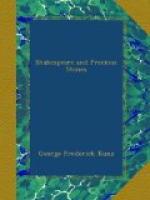[Footnote 2: On the pearls brought to Europe from both North and South America in Shakespeare’s time, see the writer’s “Gems and Precious Stones of North America”, New York, 1890, pp. 240-257; 2d. ed., 1892.]
Many fine pearls of the fresh-water variety, not the marine pearls, were found in the Scotch rivers. It was these that are mentioned as having been obtained by Julius Caesar to ornament a buckler which he dedicated to the shrine of the Temple of Venus Genetrix. It was also this type of pearl that was so eagerly sought by the late Queen Victoria when she visited Scotland. Many of these pearls exist in old, especially in ecclesiastical jewelry, and several are in the Ashburnham missal now in the J. Pierpont Morgan library.[3]
[Footnote 3: See “The Book of the Pearl”, by George Frederick Kunz and Charles Hugh Stevenson, New York, 1908, colored plate opposite p. 16.]
Of the glowing ruby Shakespeare seems to have known little, since he uses its name only in the conventional way to signify a bright or choice shade of red. In Measure for Measure (Act ii, sc. 4) the “impression of keen whips” produced ruby streaks on the skin; even more materialistic is the nose “all o’er embellished with rubies, carbuncles and sapphires” (Comedy of Errors, Act iii, sc. 2). The common employment of the designation carbuncle for a precious stone and also for a boil was usual from ancient times. At least, we might gather from this passage that the poet was aware of the distinction between ruby and carbuncle (pyrope garnet). Rubies as “fairy favors” is a dainty mention in the fairy drama Midsummer Night’s Dream (Act ii, sc. 1). Caesar’s wounds “ope their ruby lips” (Julius Caesar, Act iii, sc. 1). Macbeth speaks of the “natural ruby of your cheeks”, in addressing his wife at the apparition of Banquo’s ghost; with her this is unchanged, while with him terror or remorse has blanched it (Macbeth, Act iii, sc. 4). Lastly, the term “ruby lips”, so often used by poets, is employed by Shakespeare with consummate art in Cymbeline (Act ii, sc. 2) where he writes:
But kiss; one
kiss! Rubies unparagon’d,
How dearly they
do’t.
First Folio,
“Tragedies”, p. 376, col. B, line
18.
The “rubies” of the poet’s time were frequently ruby spinels, or the so-called “balas rubies” from Badakshan, in Afghan Turkestan. The most noted one in the England of that period was probably the one said to have been given to Edward the Black Prince by Pedro the Cruel of Castile, after the battle of Najera, in 1367, and now the most prized adornment of the English Crown, excepting the great historic diamond, the Koh-i-nur. The immense Star of South Africa, weighing 531 metric carats, five times the weight of the Koh-i-nur, is intrinsically worth much more, but lacks the manifold dramatic and historic associations of its Indian sister.
Strange to say, the beautiful sapphire is only twice named by Shakespeare, once as an adjunct to the pearl in embroidery (Merry Wives of Windsor, Act v, sc. 5). The single mention of chrysolite is much more impressive:




